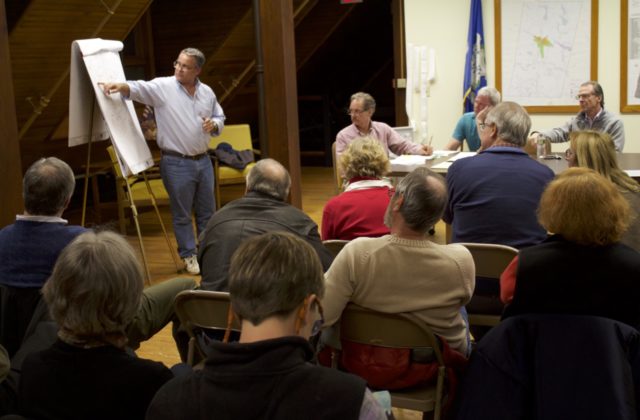Inland Wetlands Commission Approves City Meadow Plan
Residents show concern and support at public hearing
By Wiley Wood
After a public hearing on the second floor of Town Hall on the evening of Monday, Dec. 5, the Inland Wetlands Commission voted to approve the City Meadow plan, which will reclaim the sunken wetland below Station Place from invasive species and provide public access to it from Route 44 and Shepard Road.
Steven Trinkaus, the project engineer, outlined the proposed changes for the benefit of the commission and some 35 members of the public.
The tall stand of phragmites now filling the wet meadow will be replaced with native plants. The new focal point will be a small pond, located near the firehouse. A boardwalk will loop through the area, with a viewing platform near the pond. The Shepard Road entrance will have a small parking lot surfaced with gravel.
“You could skate on the pond in the winter,” said Trinkaus. “And we’re going to put in some big rocks along the edge for kids to fish from in the summer.”
The current Wetland Restoration and Enhancement Plan received state and federal approval in April. A $500,000 grant from the state’s Main Street Improvement Fund, scheduled to lapse at year’s end, was renewed in October for a further year. The deadline for all work funded by the grant is December 2017.
Asked about a connection to the center of the business district, Trinkaus explained that because the retaining wall along John J. Curtiss Road was steep and its stability uncertain, an earlier plan to cut a path diagonally down from Station Place had been abandoned. A second plan for a series of platforms linked by stairs stepping down to the meadow has been considered and might be built at a later date, but it is not included in the present project.
John Anderson, chairman of the Conservation Commission, observed that more invasive species are present in City Meadow than were reported in the site description. He also suggested that the wet swale conducting runoff north toward Shepard Road be interrupted at a slight rise in the ground, allowing the water to disperse through the soil—as it does now—and recollect at a lower point.
Questioned more closely about the pond, Trinkaus described it as irregularly shaped, designed to measure 100 feet on its long axis and be bordered by a 6- to 8-foot wide aquatic safety shelf of very shallow water, planted with sedges, cattails and other marsh vegetation, to discourage approach by children and geese.
In its deliberations after the public hearing, the commission added a number of conditions to the plan. Among them were provisions for maintenance, a $20,000 contractor bond and the Conservation Commission’s inclusion in decisions about the plantings. The commission also adopted John Anderson’s suggestion that the center third of the wet swale be maintained as a marsh.
The vote in favor of the plan, with the commission’s 19 additional conditions, was unanimous.
Before it can be put to bid, the City Meadow plan still needs approval from the Planning and Zoning Commission, which will next meet on Dec. 13, at 6:30 p.m., at Town Hall.
Photo by Wiley Wood: Steve Trinkaus, standing on left, describes features of the proposed plan for City Meadow to the Inland Wetlands Commission and members of the public.

